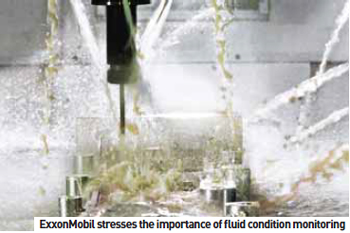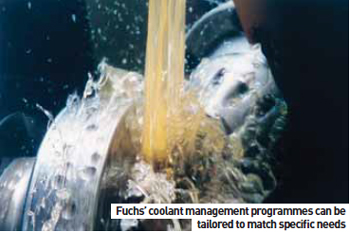
Tougher metals and more advanced and severe metalworking processes, along with the ongoing drive to increase productivity and reduce costs, have seen cutting fluids rise up the agenda at automotive machine shops.
Where a neat or aqueous (soluble/water miscible) cutting fluid is selected, it is crucial to monitor its condition going forward. The main parameters to monitor are: fluid concentration; pH value; bacterial and fungi count; dissolved salts concentration; and hardness. Fluid concentration is the most important factor to monitor and should be formally checked and recorded.
“During the lifetime of a coolant in service, fluid concentration can change widely due to water evaporation from heat generation during the cutting process and losses resulting from highly-pressured circulation,” says Peter Bird, Industrial Marketing, Europe, Africa & Middle East, ExxonMobil Lubricants and Specialties. “Close monitoring is therefore required on a daily basis and any carefullymeasured counteractions performed to remedy the problem. Simply approximating the amount of water and concentrate to balance the fluid can lead to problems such as lowering the pH value and increased bacterial activity, which will result in shorter coolant life, lower quality products and increased costs.”
According to ExxonMobil, the following actions should be carried out on a daily or weekly basis: check coolant concentration with a refractometer at the beginning of every day/shift; check pH value with pH meter or pH paper at the beginning of every day/shift; check diluting water and coolant hardness with water hardness strips every week; remove as much tramp oil as possible every week after the coolant has been static for one hour; always top up with diluted coolant, never with just water; and keep good records of coolant progress using monitoring charts.
 Another cutting fluids supplier, Fuchs Lubricants, says that the automotive sector is one of the more prevalent users of coolant management services, and many auto parts manufacturers have begun to identify the appreciable cost savings associated with professional fluid management.
Another cutting fluids supplier, Fuchs Lubricants, says that the automotive sector is one of the more prevalent users of coolant management services, and many auto parts manufacturers have begun to identify the appreciable cost savings associated with professional fluid management.
While lubricating oils and coolants represent a small percentage of total spend within most automotive manufacturing organisations, they are critically important to the success of the operation and can have a direct impact on production and maintenance costs. Research has suggested that the true cost of lubricants and coolants can often be 10 times the cost of the actual fluid itself. These increased costs manifest themselves in areas such as energy usage, maintenance activity, tool and equipment life, inventory, safety and disposal.
The service supplied by Fuchs is called Chemical Process Management (CPM), and Keith Salt, Technical Services Manager at Fuchs UK, explains why fluid management is so important.
“Through a serviced fluid management programme, manufacturers benefit from numerous efficiencies,” he says. “Success in areas such as coolant management will require the correct selection of fluid, efficient removal of tramp oil, sludge and other contaminants from the cutting fluid, together with the effective mixing, dilution and distribution to extend coolant life over its normal anticipated lifespan. This not only saves on usage and top-up costs, but also dramatically reduces disposal charges, inventory and vehicle movements on site.”
In addition to this, through consistent cutting fluid monitoring and control, machine downtime and labour costs can be enormously reduced, with tooling life extended and component corrosion eliminated. This can enable auto parts manufacturers to improve lead-times and production capacity without the need for investment in extra machinery.
 “The success of the service supplier can be measured against many different performance indicators, including fluid consumption, cost-per-unit manufactured, machinery downtime, waste generation and disposal – and all of these costs can be encompassed under a standard monthly fee,” says Salt. “A fluid management programme can be specially designed and include regular (weekly or monthly) visits to monitor coolants and a dedicated report to advise customers of best practice procedures. It can also comprise regular sampling of the lubricants in the system to advise on condition, appropriate change schedules and wear analysis via our CENT condition monitoring service.”
“The success of the service supplier can be measured against many different performance indicators, including fluid consumption, cost-per-unit manufactured, machinery downtime, waste generation and disposal – and all of these costs can be encompassed under a standard monthly fee,” says Salt. “A fluid management programme can be specially designed and include regular (weekly or monthly) visits to monitor coolants and a dedicated report to advise customers of best practice procedures. It can also comprise regular sampling of the lubricants in the system to advise on condition, appropriate change schedules and wear analysis via our CENT condition monitoring service.”
Fuchs has also devised an online fluids management system, Fluids Live, to allow automotive manufacturers to analyse and assess the performance of their machines. Data is uploaded every two hours, providing engineers with up-to-date information which can be accessed via the internet.
Honda recently turned to Eclipse Magnetics and its Micromag technology for a custom-built reaming and boring machine at its plant in Swindon, UK. The machine, designed and manufactured by Honda’s Engineering Division, is used for manufacturing engine valve seats – an engine component where accuracy and quality of surface finish is critical. Honda’s Engineers found that micro-particles of metal carried in the machine’s coolant could adversely affect the surface finish of the machined valve seat, which in turn could impair engine efficiency.
The engineer in charge of this process on site, Peter Jones, believed magnetic filtration could provide the answer. “Since incorporating Micromag into our process, we have found that, in addition to it efficiently removing potentially harmful metal particles, the unit’s maintenance friendly characteristics ensure that we now experience minimum machine downtime,” he says.
The magnetic core in the Micromag comprises neodymium iron boron magnets that generate a high intensity magnetic field. Fluid enters the housing and is evenly distributed around the underside of an aluminium lid via radial tapered flow channels. The fluid passes down the outside of the magnetic core where magnetic particles are attracted by the magnetic field.
According to Jemtech, the UK supplier of Blaser Swisslube cutting fluids, building confidence in the manufacturing sector makes now an ideal time to look at potential productivity gains.
“Correctly managed and properly selected, the cutting fluid will deliver significant payback in the form of increased cutting data, improved tolerance holding, improved surface finishes and increased uptime,” he states. “When investigating cutting fluids it is important to look at the true cost, not simply the cost per litre for concentrate. The total cost of use for cutting fluids is made up of several diverse elements: initial cost; top-up costs; cutting tool life; indirect costs (machine damage, health and safety issues, etc); maintenance costs; and of growing importance, disposal costs. The actual cost per litre to buy fluids is a very small percentage of the overall cost.”
The first step in gaining an advantage from cutting fluids is to take a close look at monitoring and useage. Gathering and logging tool life, cutting data, finishes, tolerances, number of sump changes per year, overheads, hourly rates and downtime will highlight the obvious improvement targets that will drive changes through.
For example, one Blaser Swisslube user in the automotive sector (machining cast iron components) increased tool life by 200% by switching to Blasocut BC25 fluid, generating savings in tool costs of £275 ($500) per week on one cutter alone, which equates to an annual saving of over £16,000 ($25,000) per year when other costs are taken into account. Similarly, considerable savings can be made through good management of cutting fluids.
In the case of the auto parts manufacturer, using Blasocut at a sump concentration of between seven and eight per cent and a top up of between one and two per cent (considerably lower than the previous top up levels of between four and five per cent), complemented with the installation of Fe-Ol tramp oil removing devices, sump life was increased from two weeks to 26 weeks. This generated a 76% reduction in fluid consumption, a 23% reduction in costs and reduced labour cost massively for cleaning out the sumps.
Furthermore, there is the cost of waste disposal which is considerable when changing coolant every two weeks, amounting to 45 tonnes of waste per year, this from just three machine tools.


































